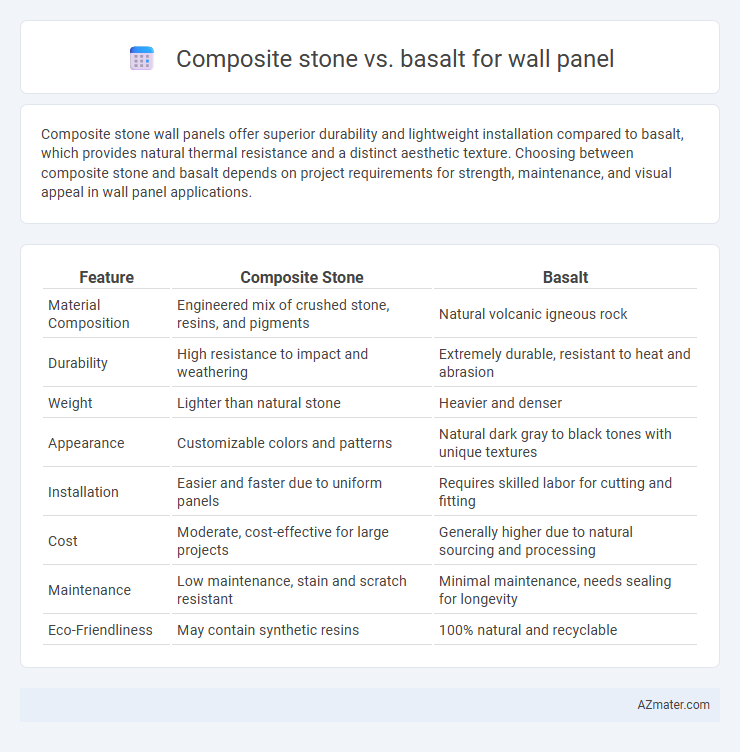Composite stone wall panels offer superior durability and lightweight installation compared to basalt, which provides natural thermal resistance and a distinct aesthetic texture. Choosing between composite stone and basalt depends on project requirements for strength, maintenance, and visual appeal in wall panel applications.
Table of Comparison
| Feature | Composite Stone | Basalt |
|---|---|---|
| Material Composition | Engineered mix of crushed stone, resins, and pigments | Natural volcanic igneous rock |
| Durability | High resistance to impact and weathering | Extremely durable, resistant to heat and abrasion |
| Weight | Lighter than natural stone | Heavier and denser |
| Appearance | Customizable colors and patterns | Natural dark gray to black tones with unique textures |
| Installation | Easier and faster due to uniform panels | Requires skilled labor for cutting and fitting |
| Cost | Moderate, cost-effective for large projects | Generally higher due to natural sourcing and processing |
| Maintenance | Low maintenance, stain and scratch resistant | Minimal maintenance, needs sealing for longevity |
| Eco-Friendliness | May contain synthetic resins | 100% natural and recyclable |
Introduction to Composite Stone and Basalt
Composite stone, engineered from a blend of natural stone aggregates and resin binders, offers enhanced durability, lightweight properties, and a wide range of customizable finishes for wall panel applications. Basalt, a naturally occurring volcanic rock, is prized for its exceptional strength, heat resistance, and unique textured appearance, making it a popular choice for both interior and exterior wall cladding. Comparing composite stone to basalt highlights differences in maintenance requirements, cost efficiency, and aesthetic versatility in architectural design.
Composition and Material Properties
Composite stone wall panels consist of natural stone particles bonded with resins and polymers, offering lightweight yet durable surfaces with high resistance to impact and moisture. Basalt, a volcanic igneous rock, is dense, hard, and exhibits exceptional thermal stability and weather resistance, making it highly suitable for exterior wall cladding. The choice between composite stone and basalt hinges on factors like weight, installation ease, and exposure conditions, with basalt providing superior strength and longevity, while composite stone offers versatility and cost-effectiveness.
Aesthetic Differences: Color and Texture
Composite stone wall panels offer a wide range of color options, including vibrant and uniform hues, with smooth or slightly textured surfaces that can mimic natural stone finishes. Basalt panels typically feature deep, rich grays to black tones with a naturally rough, volcanic texture, providing an organic and rugged aesthetic. The choice between composite stone and basalt for wall panels depends on desired visual impact: composite stone suits modern, polished looks while basalt delivers raw, natural character.
Strength and Durability
Composite stone wall panels exhibit high tensile strength and resistance to cracking due to their engineered composition, making them ideal for long-term structural integrity in various environments. Basalt, a natural volcanic rock, offers exceptional compressive strength and inherent durability, with excellent resistance to weathering and erosion. Both materials provide robust performance, but basalt generally excels in hardness and longevity, while composite stone offers enhanced impact resistance and easier installation for wall panel applications.
Installation Methods and Ease
Composite stone wall panels offer lightweight installation with adhesive backing or mechanical fasteners, allowing for quicker application and reduced labor costs. Basalt panels, being denser and heavier, often require specialized mounting systems such as stainless steel anchors or brackets, demanding more precise alignment and structural support. The ease of installing composite stone panels makes them ideal for DIY projects, whereas basalt's durability suits professional installations needing long-term stability.
Maintenance and Longevity
Composite stone wall panels offer superior resistance to stains, scratches, and fading, requiring minimal maintenance compared to basalt. Basalt, a natural volcanic rock, provides exceptional durability and longevity but may necessitate periodic sealing to prevent moisture absorption and surface weathering. The long-term cost-effectiveness of composite stone lies in its low upkeep, while basalt panels demand careful maintenance to preserve their natural aesthetic and structural integrity.
Cost Comparison of Composite Stone vs Basalt
Composite stone wall panels typically offer a cost advantage over basalt due to lower material and fabrication expenses, making them a budget-friendly alternative for large-scale projects. Basalt, being a natural volcanic rock, incurs higher costs from quarrying, cutting, and finishing processes that contribute to increased overall pricing. Maintenance and installation costs also tend to be higher for basalt panels, whereas composite stone often requires less upkeep and simpler installation techniques.
Environmental Impact and Sustainability
Composite stone wall panels often incorporate recycled materials and binders that reduce the demand for natural stone extraction, contributing to lower environmental impact and enhanced sustainability. Basalt, a natural volcanic rock, offers durability and thermal insulation benefits but requires energy-intensive quarrying and transportation processes that can increase its carbon footprint. Choosing composite stone over basalt can support eco-friendly construction by minimizing resource depletion and promoting circular economy principles in wall panel applications.
Best Applications for Wall Panels
Composite stone offers superior versatility and lightweight properties, making it ideal for interior wall panels in residential and commercial spaces where ease of installation and diverse designs are essential. Basalt, known for its exceptional durability, thermal resistance, and natural aesthetic, is best suited for exterior wall cladding and high-traffic areas requiring robust protection against weathering. Both materials excel in enhancing wall panel longevity and visual appeal, with composite stone favoring decorative applications and basalt providing structural resilience.
Choosing the Right Material: Factors to Consider
Composite stone offers lightweight durability and ease of installation, ideal for interior wall panels requiring design flexibility and lower maintenance. Basalt, a natural volcanic rock, provides exceptional strength, weather resistance, and a unique textured appearance, making it suitable for exterior applications and high-traffic areas. When choosing between composite stone and basalt for wall panels, consider factors such as environmental exposure, budget constraints, desired aesthetics, and long-term maintenance requirements to ensure optimal performance and longevity.

Infographic: Composite stone vs Basalt for Wall Panel
 azmater.com
azmater.com